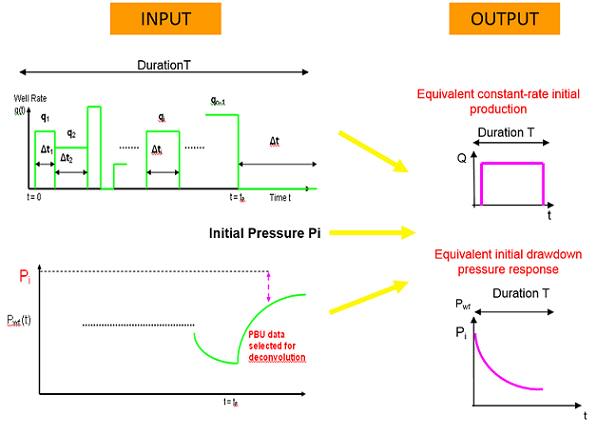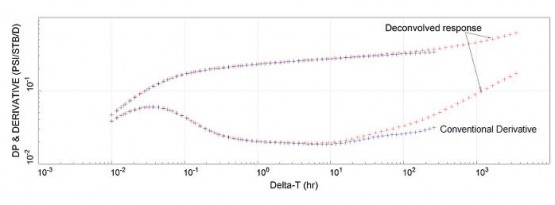Deconvolution came up about 10 years ago and has become the driving tool in well test analysis. However, deconvolution is still not often used in well test design, operations and interpretation.
Perhaps due to these 5 main misconceptions.
What is Deconvolution…?
In a linear system with a single well, the well flowing pressure is given by the “convolution integral” (also called Duhamel’s principle or superposition principle):

With Pi: initial pressure, Pwf(t): well flowing pressure at bottom-hole conditions, q(t) is the sandface well rate and pu(t) the well pressure response due to a constant unit-rate production.
The constant-rate drawdown response pu (t) can be obtain from initial pressure Pi, the well pressure from one or more PBU tests and the rate data.
As a result, the deconvolution technique transforms variable rate and pressure data into an equivalent initial constant-rate pressure response (in purple in the plot above) with duration equal to the duration T of the entire test.
Plotting this response and its derivative with respect to the log of time (log t) in the derivative plot (or log-log plot) gives the deconvolved response, as shown in red in the figure below.
The duration of the deconvolved derivative plot is equal to that of the entire test sequence, from well start-up to the time when the PBU test is performed. In addition, deconvolution is free from any error, which explains the discrepancy between the conventional derivative (in blue) and deconvolution (in red).
Yes this is all fine, but:
“I don’t need deconvolution (and I don’t need to learn it), I am perfectly happy with my good old derivative. It does the job! ”
If you understand the conventional derivative, you’ll understand the deconvolved derivative: it has the same principles, the same slopes for the different flow regimes, etc… All the things that you learnt with the conventional derivative can be applied with deconvolution. The only main differences are that the deconvolved derivative lasts longer and is free of distortion (error due to the way the conventional derivative is calculated). So deconvolution improves your understanding of the pressure transient response. In fact, we could say that if you understand deconvolution, you truly understand well test analysis.
Deconvolution is a sort of “improved” derivative and it improves the understanding of the pressure transient response. Since it is developed over a longer time interval, deconvolution will bring more constraints and as a result will help reduce non-uniqueness and minimize the range of possible values.
Deconvolution helps to give technical evidence to increase the connected volume, refine initial pressure and even shorten the shut-in period. On one occasion, we showed that deconvolution could help to reduce shut-in time by more than 70% and provide technical evidence to increase the connected hydrocarbon volume by more than 30%.
And when you already have the data, it is free to use! Most likely, you will get much more value out of your data and with a lower cost. On some occasions, you could even reduce the shut-in duration by some few days, with some big impact on operations. (given about half million dollars rig cost…)
Are you sure you don’t want to investigate deconvolution… ?
“Deconvolution is not real, it is all mathematics”.
There is a lot of maths with the algorithm to extract the deconvolved response, but not much more than behind the well test theory. Plus, you don’t need to get any of these mathematics to fully understand what deconvolution is and how to use it.
Whether we are talking about the conventional or deconvolved derivative, both are not measured but calculated. So both are “not real”…
“Deconvolution has a very limited application, it needs linear flow equations.”
Indeed, deconvolution should work only with linear flow equations, when the superposition theory is valid. But this is the same as for the well test theory. Strictly speaking, conventional derivative should only be applied to linear systems. However, some critical and valid information can still be extracted about the well and reservoir, even with non-linear equations. (there will be a video session on well and reservoir surveillance with well test analysis).
On some occasions, single well deconvolution can still be used with the onset of a gas breakout or liquid dropout, on some water injectors, in the presence of (weak) interference, etc… And we still find ways to bypass current limitations with new enhancements.
“I never can recover a reliable deconvolution. It is too sensitive to small changes of parameters or it doesn’t seem to work.”
Well on some occasions, deconvolution won’t work, it’s simple as that. For example, if you are using pressure data from a shallow gauge or if there is heavy multiphase flow in the reservoir, deconvolution will probably fail.
In each case, you need to ensure the validity of deconvolution before using it in the analysis.
There are some particular techniques and processes to recover a reliable deconvolved response, some as simple as cleaning the data.
You also need to make sure that you have enough information to derive a reliable deconvolved response. This is particularly critical when designing new acquisition of pressure data.
“Some colleagues (boss) still don’t believe in deconvolution and don’t trust the results of deconvolution”.
There will always be people that are not too excited about advances and new techniques, even if it can help your company get more valuable data at a lower cost.
If you checked the validity of deconvolution, used it as a driving tool and checked that the other verification tools were matched, then your confidence should be pretty high. If someone doesn’t want to use this technique, just remove the deconvolution plot from your analysis and show only the other tools. Win-Win…



